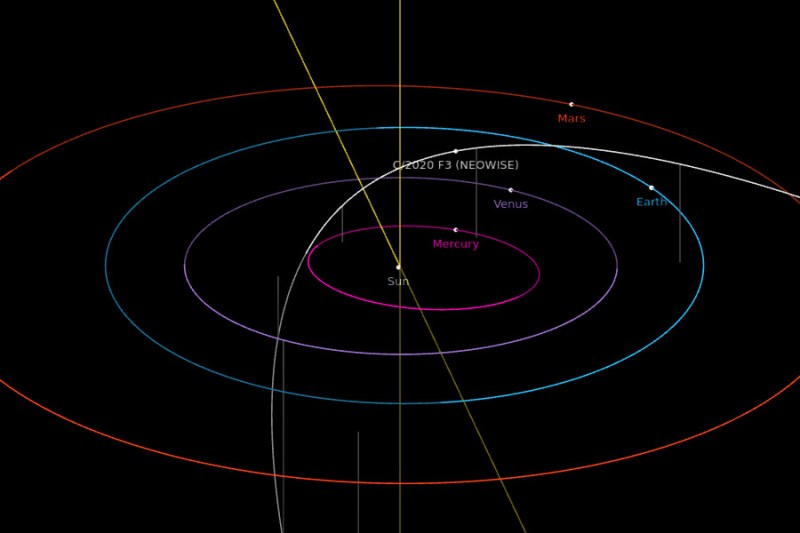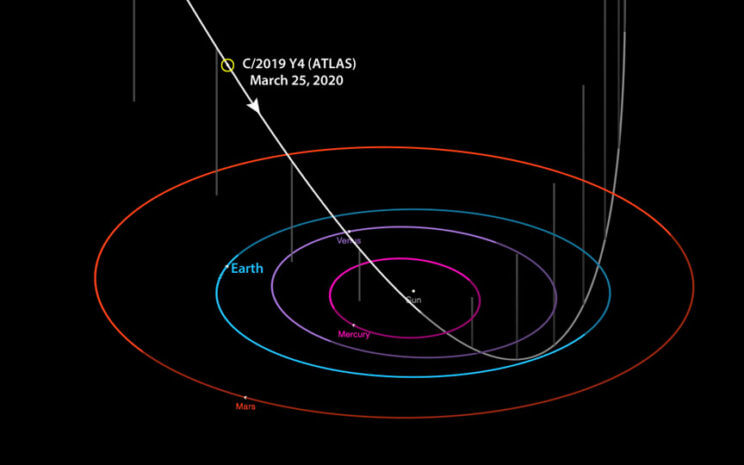Halley's Comet or Comet Halley, officially designated 1P/Halley, is a short-period comet visible from Earth every 75–76 years. Halley is the only known short-period comet that is regularly visible to the naked eye from Earth, and the only naked-eye comet that can appear twice in a human lifetime. Halley last appeared in the inner parts of the Solar System in 1986 and will next appear in mid. The image of Comet Hale-Bopp blazing across the night sky of 1997 has delighted casual stargazers and astronomers alike. It was first spotted in July 1995 by Alan Hale and Thomas Bopp, who.
Original file (SVG file, nominally 470 × 230 pixels, file size: 103 KB)
Summary
| Description | English: Orbital diagram for Comet Hale-Bopp. The positions of the comet and the planets are as in April 1, 1997 (at the perihelion). Based on ephemeris data from horizons by NASA Français : Diagramme de l'orbite de la comète Hale-Bopp. La position de la comète et des planètes sont données au 1er avril 1997, le périhélie. Basé sur les données d'éphémérides de horizons de la NASA |
| Date | |
| Source | Own work (Original text: I created this work entirely by myself.) |
| Author | Random astronomer (talk) |
Licensing
| This file is licensed under the Creative CommonsAttribution-Share Alike 3.0 Unported license. | |
| Attribution: Random astronomer at English Wikipedia | |
|
| Permission is granted to copy, distribute and/or modify this document under the terms of the GNU Free Documentation License, Version 1.2 or any later version published by the Free Software Foundation; with no Invariant Sections, no Front-Cover Texts, and no Back-Cover Texts. A copy of the license is included in the section entitled GNU Free Documentation License. |
Original upload log
Transferred from en.wikipedia to Commons by Trassiorf using CommonsHelper.
- 2008-12-05 17:13 Random astronomer 470×230× (105324 bytes)
- 2008-12-05 17:11 Random astronomer 470×230× (94736 bytes)
- 2008-11-29 21:11 Random astronomer 470×230× (97962 bytes) tweak
- 2008-11-29 20:42 Random astronomer 470×230× (97928 bytes) better?
- 2008-11-29 20:29 Random astronomer 470×230× (104487 bytes)
- 2008-11-29 20:23 Random astronomer 256×256× (104462 bytes) {{Information |Description=Orbital diagram for Comet Hale-Bopp |Source=I created this work entirely by myself. |Date=Nov 29, 2008 |Author=~~~ |other_versions= }}
Captions

File history

Click on a date/time to view the file as it appeared at that time.
| Date/Time | Thumbnail | Dimensions | User | Comment |
|---|---|---|---|---|
| current | 10:26, 12 April 2010 | 470 × 230 (103 KB) | File Upload Bot (Magnus Manske) | {{BotMoveToCommons|en.wikipedia|year={{subst:CURRENTYEAR}}|month={{subst:CURRENTMONTHNAME}}|day={{subst:CURRENTDAY}}}} {{Information |Description={{en|Orbital diagram for Comet Hale-Bopp. The positions of the comet and the planets are as in April 1, 1997 |
File usage
Global file usage

The following other wikis use this file:
- Usage on el.wikipedia.org
- Usage on fr.wikipedia.org
- Usage on ja.wikipedia.org
- Usage on ms.wikipedia.org
- Usage on si.wikipedia.org
- Usage on uk.wikipedia.org
Metadata
The current estimate is circa 4380 CE. Hale-Bopp's orbital period was altered due to the gravitational effects of approaching Jupiter as closely as 0.77AU (1 AU = average distance between earth and sun) in April 1996. The orbital period before it approached the solar system planets was about 4200 years, which changed to 2380 years following the gravitational interaction with Jupiter.

Like most comets, Hale-Bopp also releases large jets of easily vaporized material when it approaches the sun. While predominantly H2O, many other compounds such as acetaldehyde, prussic acid, and hydrogen sulfide are also present in these jets. Even though such outgassing has been modeled, it introduces additional uncertainties to orbital period estimation.
Comet Hale-bopp Orbit
This page was last updated on July 18, 2015.

Comments are closed.